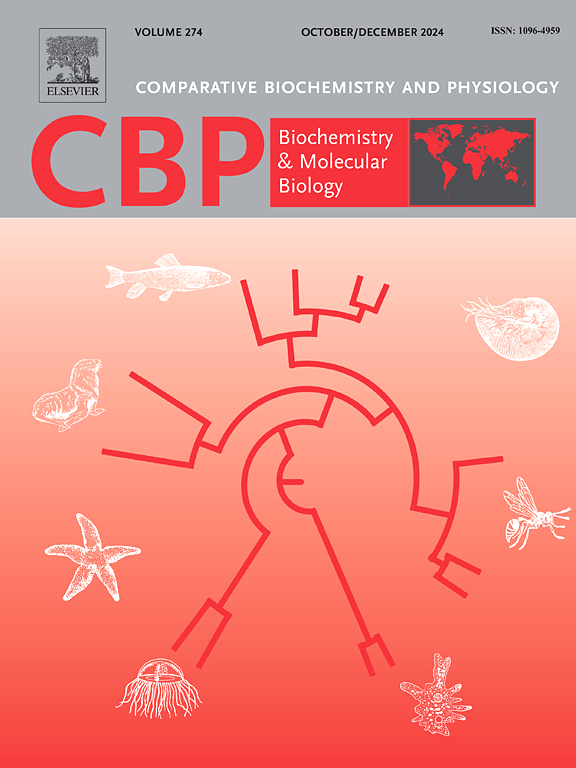Developmental exposure to constant elevated temperatures and diel thermal variation alters microRNA expression and performance in zebrafish (Danio rerio).
IF 1.8
3区 生物学
Q4 BIOCHEMISTRY & MOLECULAR BIOLOGY
Comparative Biochemistry and Physiology B-Biochemistry & Molecular Biology
Pub Date : 2025-07-09
DOI:10.1016/j.cbpb.2025.111122
引用次数: 0
Abstract
In their natural environments, fish are exposed to diel thermal fluctuations, the range of which is expected to increase dramatically with climate change. Recently, it has been posited that epigenetic modulators like microRNAs (miRNAs) could buffer fish against such changes. To investigate this, we conducted two sequential experiments using zebrafish (Danio rerio). In Experiment 1, we exposed zebrafish to constant control (CTRL; 28°C), fluctuating (FLUX; 28±5°C), or elevated (HEAT; 33°C) temperatures throughout early development (embryo to juvenile, up to 30 days post-fertilization [dpf]). Throughout early development, we assessed survival, metabolism, and the expression of seven thermosensitive miRNAs and three heat shock proteins (HSPs). While HEAT conditions significantly reduced survival, FLUX exposure did not. Both FLUX and HEAT juveniles exhibited metabolic compensation, though this was more pronounced in FLUX fish. Notably, miR-181a-5p, which regulates mitochondrial biogenesis and respiration, was significantly upregulated in FLUX juveniles, suggesting its involvement in improving metabolic performance. Experiment 2 evaluated the long-term effects of ontogenetic thermal variability. Starting at 30 dpf, remaining fish in both CTRL and FLUX treatments were maintained under CTRL conditions until adulthood. We then assessed miRNA expression in the brain and thermal tolerance (CTmax). miR-181a-5p remained elevated in the brains of adult fish with FLUX developmental histories, though CTmax was unaffected. Together, these findings suggest that early-life exposure to diel thermal fluctuations induces lasting epigenetic changes, potentially optimizing metabolic performance in the short-term at the cost of reduced capacity for further thermal tolerance and stress recovery later in life.

在斑马鱼的发育过程中,暴露于持续升高的温度和昼夜温差会改变microRNA的表达和表现。
在它们的自然环境中,鱼类面临着剧烈的热波动,其范围预计将随着气候变化而急剧增加。最近,有人认为表观遗传调节剂如microRNAs (miRNAs)可以缓冲鱼类对这些变化的影响。为了研究这一点,我们用斑马鱼(Danio rerio)进行了两次连续实验。在实验1中,我们将斑马鱼暴露于恒定控制(CTRL;28 °C),波动(FLUX;28 ± 5 °C),或升高(HEAT;33 °C)的温度贯穿整个早期发育(胚胎到幼崽,直至受精后30 天[dpf])。在整个早期发育过程中,我们评估了存活、代谢和7种热敏mirna和3种热休克蛋白(HSPs)的表达。虽然HEAT条件显著降低了生存率,但FLUX暴露没有。FLUX和HEAT幼鱼都表现出代谢补偿,尽管这在FLUX鱼中更为明显。值得注意的是,调节线粒体生物发生和呼吸的miR-181a-5p在FLUX幼鱼中显著上调,表明其参与改善代谢表现。实验2评估了个体发生热变率的长期影响。从30 dpf开始,其余的鱼在CTRL和FLUX处理下都保持在CTRL条件下直到成年。然后我们评估了miRNA在脑中的表达和热耐受性(CTmax)。miR-181a-5p在具有FLUX发育历史的成年鱼的大脑中保持升高,但CTmax不受影响。总之,这些发现表明,生命早期暴露于昼夜热波动会引起持久的表观遗传变化,可能会在短期内优化代谢性能,但代价是在生命后期进一步的热耐受性和应激恢复能力降低。
本文章由计算机程序翻译,如有差异,请以英文原文为准。
求助全文
约1分钟内获得全文
求助全文
来源期刊
CiteScore
4.60
自引率
4.50%
发文量
77
审稿时长
22 days
期刊介绍:
Comparative Biochemistry & Physiology (CBP) publishes papers in comparative, environmental and evolutionary physiology.
Part B: Biochemical and Molecular Biology (CBPB), focuses on biochemical physiology, primarily bioenergetics/energy metabolism, cell biology, cellular stress responses, enzymology, intermediary metabolism, macromolecular structure and function, gene regulation, evolutionary genetics. Most studies focus on biochemical or molecular analyses that have clear ramifications for physiological processes.

 求助内容:
求助内容: 应助结果提醒方式:
应助结果提醒方式:


